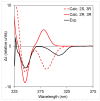Bromotryptamine and Bromotyramine Derivatives from the Tropical Southwestern Pacific Sponge Narrabeena nigra
- PMID: 31151240
- PMCID: PMC6627171
- DOI: 10.3390/md17060319
Bromotryptamine and Bromotyramine Derivatives from the Tropical Southwestern Pacific Sponge Narrabeena nigra
Abstract
So far, the Futuna Islands located in the Central Indo-Pacific Ocean have not been inventoried for their diversity in marine sponges and associated chemical diversity. As part of the Tara Pacific expedition, the first chemical investigation of the sponge Narrabeena nigra collected around the Futuna Islands yielded 18 brominated alkaloids: seven new bromotryptamine derivatives 1-7 and one new bromotyramine derivative 8 together with 10 known metabolites of both families 9-18. Their structures were deduced from extensive analyses of nuclear magnetic resonance (NMR) and high-resolution mass spectrometry (HRMS) data. In silico metabolite anticipation using the online tool MetWork revealed the presence of a key and minor biosynthetic intermediates. These 18 compounds showed almost no cytotoxic effect up to 10 µM on human neuroblastoma SH-SY5Y and microglia BV2 cells, and some of them exhibited an interesting neuroprotective activity by reducing oxidative damage.
Keywords: Bromotryptamine; Bromotyramine; Futuna; Narrabeena; Porifera; aromatic alkaloids; coral reefs; neuroprotective agents.
Conflict of interest statement
The authors declare no conflict of interest. The funders had no role in the design of the study; in the collection, analyses, or interpretation of data; in the writing of the manuscript, or in the decision to publish the results.
Figures








References
-
- Firsova D., Mahajan N., Solanki H., Morrow C., Thomas O.P. Current Status and Perspectives in Marine Biodiscovery. In: Paterson R., Lima N., editors. Bioprospecting: Success, Potential and Constraints. Volume 16. Springer International Publishing AG; Cham, Switzerland: 2017. pp. 29–50.
-
- Jaspars M., De Pascale D., Andersen J.H., Reyes F., Crawford A.D., Ianora A. The marine biodiscovery pipeline and ocean medicines of tomorrow. J. Mar. Biol. Assoc. UK. 2016;96:151–158. doi: 10.1017/S0025315415002106. - DOI
MeSH terms
Substances
Grants and funding
LinkOut - more resources
Full Text Sources
Research Materials

